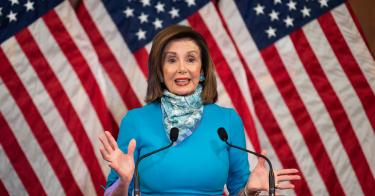Speaker Nancy Pelosi and her fellow House Democrats are seeking a more than $1 trillion federal bailout for state and local governments. This is in addition to the unprecedented aid Congress already has sent.
Instead of waiting on a handout from Washington, states should clear the way for a more robust economic recovery by addressing their unsustainable finances.
States and local government spending has increased over the recent past, demonstrating room for targeted spending cuts.
After adjusting for inflation and increases in population, state and local spending (in constant 2019 dollars) has grown from $5,596 per person in 2000 to $7,268 per person in 2019.
That amounts to a 30% increase in the real cost of state and local government over just two decades, even without the thousands of dollars per person the federal government sends to states and localities through a wide variety of programs.
But not all states spend equally. As of 2017, Florida, Georgia, and Arizona spent about $5,800 per person on state and local governments, but New York spent more than $11,700 per person.

Financing state and local governments’ lost revenues would mean spending twice as much on New Yorkers as on residents in more frugal states.
The gap between big-spending states and fiscally responsible states has increased markedly over the last two decades, as this graph of state-level spending changes from 2000 to 2019 demonstrates.

California increased state-level spending by 52% and New York by 49% over the past two decades. Spending on health and education more than doubled in both states, yet health and education outcomes remain unremarkable compared to the rest of the nation.
Meanwhile, Texas has kept spending about flat, and Florida has reduced spending levels by 16%. Former Florida Gov. Rick Scott explained recently in The Wall Street Journal how fiscal discipline has set up his state for fiscal success amid this crisis.
States and localities could save more than $500 billion a year by trimming their per-person spending to where it was in 2000. This would more than cover any temporary reductions in revenue and help set the path for a stronger economic recovery.
During past recessions, countries that addressed their debt crises through spending cuts were able to return to economic growth more quickly. Those that relied on tax increases but did not reduce spending or address underlying fiscal problems, such as underfunded and overpromised pensions, experienced “deep and prolonged recessions.”
A federal bailout could prop up failing states temporarily but would not fix their underlying fiscal challenges. Instead, historical evidence suggests that every federal bailout dollar will increase state taxes by between 33 and 42 cents—the last thing residents in debt-ridden economically deprived states need.
Prolonged recessions and continued budget problems are the most likely outcome of a federal bailout for state budgets.
In addition to hundreds of billions in direct aid for the pandemic response and Federal Reserve loans for lost revenue, Congress has authorized more than $1.3 trillion in federal payments to businesses and individuals. These programs will help buoy tax revenues in every state, although much of the gains won’t be realized until states reopen.
States that still have shortfalls need to do what ordinary Americans and businesses do in such situations—make tough budgeting choices and reduce spending.
Rather than asking for a federal handout, California, Illinois, and New York should try to make their budgets look more like those of Texas and Florida.
Reducing spending in times of crisis will set up states for a successful recovery by keeping taxes low and ensuring confidence in the state’s financial future.
This piece originally appeared in The Daily Signal




